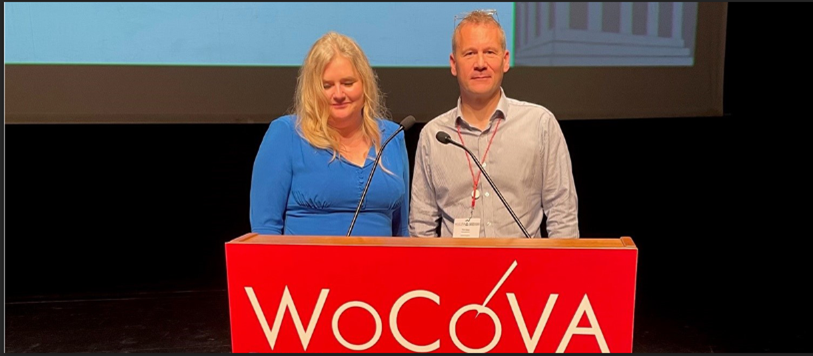Experts answer 5 pressing questions on vascular access at WoCoVA 2022
At the 7th World Congress of Vascular Access (WoCoVA), vascular access professionals and practitioners gathered in Athens, Greece 16-18th October, 2022 to collaborate on vascular access best practices and how to best serve patients now and in the future.
Three BD-sponsored symposiums brought together regional vascular access experts to answer some of the most pressing questions surrounding vascular access on topics including vascular access ethics, human factors in vascular access, and the clinical and economic outcomes of PVC care bundles:
1. What are the 4 Ethical Principles in Healthcare, and how do they relate to vascular access? 1
Catherine Hale, Associate Professor and Post-Graduate Academic Lead at The Medical School, University of Warwick, UK, previously a lawyer, explained the 4 Ethical Principles in Healthcare and how they influence vascular access: autonomy, beneficience, non-maleficence and justice.
However, Prof Hale explained that these principles are overly simplistic. For example, she presented the conflict between autonomy and beneficence when a patient refuses informed consent to beneficial treatment, or the constant battle between beneficence and non-maleficence, as most procedures carry risks and possible side effects.
Learn more about the 4 Ethical Principles in Healthcare and watch Prof Hale’s presentation: Why ethics is more important to vascular access than ever
2. How can we prevent human errors in healthcare for greater patient safety?2
Despite the need for ethical vascular access and practical clinical wisdom, preventable harm does still occur in 6% of patients across medical care settings, and 12% of preventable harm causes permanent disability or death.3
Dr Tim Kane, MD, cited this study. Dr Kane, Co-Director and Founder of Practical Patient Safety Solutions (PPSS) and Consultant Orthopaedic Surgeon at the Portsmouth NHS Trust, UK, followed Prof Hale to discuss human errors in healthcare and practical solutions to a structured, reliable healthcare institution. He began his presentation by asking the question: “How do we design and operate a system with inconsistent and unreliable human beings at its core?”
High reliability organisations both in and outside of healthcare, Dr Kane explained, are underpinned by reliable safety management systems and work to remove blame culture in the event of an accident. Four key actions that high reliability organisations take include:
Learning from near-misses/accidents with proper root cause analysis
- Creating and using robust systemwide standard operational procedures
- Training staff on why and how to follow these procedures
- Monitoring staff compliance and conditions at the front line
Above all, Dr Kane said, “Collaboration is absolutely the way forward.”
Learn more about high reliability organisations: How to improve the reliability of healthcare, from Sir David Dalton
3. Developing vascular access teams in Europe—are we there yet?4
In order to advance patient safety and create sustainable practices in vascular access, the implementation of vascular access teams (VATs) can be a key enabler5—but what is the current status of implementation across Europe?
Dr Fulvio Pinelli, MD, Consultant Cardiac Anaesthesiologist, Intensivist, and Director of the Vascular Access Centre at Careggi University Hospital in Florence, Italy, described the structure of his institution’s vascular access approach. Despite innovations in his own hospital, Dr Pinelli said, “The current landscape of vascular access management as a discipline across Europe is relatively unknown.”
According to a 2020 survey across nearly 1,500 healthcare professionals in six European countries, the availability of VATs is still inconsistent. Implementation could be slow due to a lack of investment, insufficient evidence base or a general lack of awareness around the benefits of VATs.6
Learn more about Dr Pinelli’s study: The state of vascular access teams: Results of a European survey
4. How can we systematically implement vascular access teams in hospitals?7
“We know that standardised practice is safe,” said Andrew Barton, RCN, Nurse Consultant, IV Therapy and Vascular Access, Frimley Health NHS Foundation Trust, UK and Chair of the UK National Infusion & Vascular Access Society (NIVAS), “and we know that having a vascular access team will benefit the organisation and improve safety and patient experience.” Post-pandemic, Barton and the NIVAS board envisioned a three-year plan to help standardise vascular access care across the UK.
This vision began with a white paper, calling upon NHS England to develop standardised vascular access team structures in every NHS hospital. The paper:
- Outlines a standardised structure and approach for the NHS to deliver vascular access teams to every hospital
- Recommends the creation of a national framework for nursing vascular access teams
- Builds a business case for the creation or evolution of vascular access teams
- Sets out the financial savings and positive clinical impact on patients having a vascular access team
Learn more about the NIVAS white paper: The benefits of a vascular access team
5. Are vascular access care bundles cost effective, and can they help reduce complications?8,9
Coupled with vascular access teams, vascular access care bundles are another innovative way to standardise and improve patient care.
To respond to the lack of data on the subject, Prof Olivier Mimoz, Head of Emergency Department and Pre-Hospital Care at the Poitiers University Hospital in France, teamed up with other vascular access experts to discover if peripheral venous catheter (PVC) care bundles were clinically effective.
Known as the CLEAN3 study, this clinical trial compared the use of the standard device approach to an innovative PVC care bundle in preventing catheter failure.10 As suggested, the PVC care bundle strategy was more effective.10 Prof Mimoz and his team conducted a second study to analyse the cost-effectiveness of these innovative bundled devices in the prevention of unscheduled removal based on the data of the CLEAN3 trial.11
“What we can conclude from our work is that the bundled devices passed the test for cost-effectiveness within a conservative scenario,” assured Prof Mimoz.
Learn more about the CLEAN3 studies: Peripheral venous catheters: Cost impact of PVC care bundles
To continue the conversation on clinical and cost-effective benefits of vascular acess care bundles, the next presentation came from Prof Ilker Devrim, MD, MSc, Chair of Infection Control Committee in the Department of Pediatric Infectious Diseases at the Dr Behcet Uz Children’s Hospital in İzmir, Turkey.
“Whatever you use as a catheter in your institution,” Prof Devrim said. “If you don’t have an organised care bundle, you will lose that catheter. It’s only a matter of time.” He went on to explain how the implementation of vascular access care bundles in his hospital has helped reduce central line-associated bloodstream infections (CLABSIs), and how they can impact healthcare budget.
In fact, Prof Devrim’s bundle approach includes more than just devices. At the Dr Behcet Uz Children’s hospital, a vascular access care bundle includes staff education and training, daily reviews of the need for a central line, maximal barrier precautions and hand hygiene.
References
- Hale, C. Ethics of Vascular Access. Lecture presented at: The 7th World Congress on Vascular Access (WoCoVA); 17 October, 2022; Athens, Greece.
- Kane, T. The importance of clinical human factors in healthcare—A collaborative approach to learning. Lecture presented at: The 7th World Congress on Vascular Access (WoCoVA); 17 October, 2022; Athens, Greece.
- Panagioti M, Khan K, Keers RN, et al. Prevalence, severity, and nature of preventable patient harm across medical care settings: systematic review and meta-analysis. BMJ. 2019 Jul 17;366:l4185. doi: 10.1136/bmj.l4185.
- Pinelli, F. A survey on VATs across Europe & Perspectives on VATs from a European Panel. Lecture presented at: The 7th World Congress on Vascular Access (WoCoVA); 18 October, 2022; Athens, Greece.
- National Infusion and Vascular Access Society (NIVAS). The Benefits of a Nursing Led Vascular Access Service Team. Published June 2022. Accessed December 7, 2022 at: https://nivas.org.uk/contentimages/main/NIVAS-White-paper-for-standardisation-of-vascular-access-teams-within-the-NHS_FINAL-27.06.22.pdf
- Rey NC, Pinelli F, van Loon FHJ et al. The state of vascular access teams: Results of a European survey. Int J Clin Pract. 2021 Dec;75(12):e14849. doi: 10.1111/ijcp.14849. Epub 2021 Sep 30.
- Barton, A. The Benefits of a Nursing Led VAT: The journey to a UK VAT white paper. Lecture presented at: The 7th World Congress on Vascular Access (WoCoVA); 18 October, 2022; Athens, Greece.
- Mimoz, O. Prevention of peripheral venous catheter complications: The CLEAN3 clinical trial & cost effectiveness evaluation. Lecture presented at: The 7th World Congress on Vascular Access (WoCoVA); 16 October, 2022; Athens, Greece.
- Devrim, I. A clinical & cost effectiveness perspective on care bundles for preventing CLASBI. Lecture presented at: The 7th World Congress on Vascular Access (WoCoVA); 16 October, 2022; Athens, Greece.
- Guenezan J, Marjanovic N, Drugeon B, et al. Chlorhexidine plus alcohol versus povidone iodine plus alcohol, combined or not with innovative devices, for prevention of short-term peripheral venous catheter infection and failure (CLEAN 3 study): an investigator-initiated, open-label, single centre, randomised-controlled, two-by-two factorial trial. Lancet Infect Dis. 2021;21(7):1038–48. doi: 10.1016/S1473-3099(20)30738-6.
- Maunoury F, Drugeon B, Boisson M, et al. Cost-effectiveness analysis of bundled innovative devices versus standard approach in the prevention of unscheduled peripheral venous catheters removal due to complications in France. PLoS One. 2022 Jun 14;17(6):e0269750. https://doi.org/10.1371/journal.pone.0269750
The presentations are made on behalf of BD and contain the opinions, techniques and practices by their respective speakers. The opinions and techniques presented herein are for informational purpose only.
This list of references to third-party peer-reviewed material and the sites they are hosted on are provided for your reference and convenience only, and do not imply any review or endorsement of the material or any association with their operators. The Third-Party References (and the Web sites to which they link) may contain information that is inaccurate, incomplete, or outdated. Your access and use of the Third Party Sites (and any Web sites to which they link) is solely at your own risk.
BD-78404




